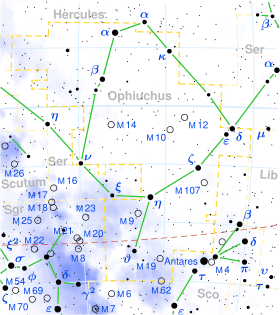Eta Ophiuchi
| Observation data Epoch J2000 Equinox J2000 | |
|---|---|
| Constellation | Ophiuchus |
| Right ascension | 17h 10m 22.68689s[1] |
| Declination | –15° 43′ 29.6639″[1] |
| Apparent magnitude (V) | 2.43[2] (3.05/3.27)[3] |
| Characteristics | |
| Spectral type | A1 IV + A1 IV[3] |
| U−B color index | +0.09[2] |
| B−V color index | +0.05[2] |
| Astrometry | |
| Radial velocity (Rv) | –0.9[4] km/s |
| Proper motion (μ) | RA: +40.13[1] mas/yr Dec.: +99.17[1] mas/yr |
| Parallax (π) | 36.91 ± 0.80[1] mas |
| Distance | 88 ± 2 ly (27.1 ± 0.6 pc) |
| Orbit[3] | |
| Period (P) | 87.58 ± 1.00 yr |
| Semi-major axis (a) | 1.396 ± 0.010" |
| Eccentricity (e) | 0.950 ± 0.020 |
| Inclination (i) | 95.2 ± 2.0° |
| Longitude of the node (Ω) | 38.9 ± 1.0° |
| Periastron epoch (T) | 2024.68 ± 0.50 |
| Argument of periastron (ω) (secondary) | 274.8 ± 2.0° |
| Details | |
| Metallicity [Fe/H] | −0.01[5] dex |
| η Oph A | |
| Mass | 2.966[3] M☉ |
| Radius | 2.5/2.0 R☉ |
| Luminosity | 35/21 L☉ |
| Temperature | 8900/8600 K |
| Rotational velocity (v sin i) | 23[6] km/s |
| η Oph B | |
| Mass | 3.478[3] M☉ |
| Other designations | |
| Database references | |
| SIMBAD | data |
Eta Ophiuchi (η Ophiuchi, abbreviated Eta Oph, η Oph), also named Sabik,[7] is a binary star in the constellation of Ophiuchus.
Properties
Eta Ophiuchi is a binary system that is difficult to resolve in amateur telescopes but whose true nature was determined through use of more advanced techniques. The primary star (whose observational data make up the table in this article) is actually only slightly larger and hotter than its companion. Individually each star is a fairly unremarkable A class main sequence star, but as a binary pair they are unusual. Each star orbits around a common center in a close and highly elliptical orbit, making planetary formation unlikely in this system and some stellar data imprecise.
Eta Ophiuchi is the northern pole star of the planet Uranus.
Nomenclature
η Ophiuchi (Latinised to Eta Ophiuchi) is the system's Bayer designation. The two components are designated Eta Ophiuchi A (the primary) and Eta Ophiuchi B.
It bore the traditional name Sabik. In 2016, the International Astronomical Union organized a Working Group on Star Names (WGSN)[8] to catalogue and standardize proper names for stars. The WGSN approved the name Sabik for this star on 21 August 2016 and it is now so entered in the IAU Catalog of Star Names.[7]
In Chinese, this star is considered part of 天市左垣 (Tiān Shì Zuǒ Yuán), meaning Left Wall of Heavenly Market Enclosure, which refers to an asterism representing eleven old states in China that mark the left borderline of the enclosure, consisting of Eta Ophiuchi, Delta Herculis, Lambda Herculis, Mu Herculis, Omicron Herculis, 112 Herculis, Zeta Aquilae, Theta1 Serpentis, Eta Serpentis, Nu Ophiuchi and Xi Serpentis.[9] Consequently, Eta Ophiuchi itself is known as 天市左垣十一 (Tiān Shì Zuǒ Yuán shíyī, English: the Eleventh Star of Left Wall of Heavenly Market Enclosure), representing the state Song(宋).[10][11]
Namesake
USS Sabik (AK-121) was a United States Navy Crater class cargo ship named after the star.
References
- 1 2 3 4 5 van Leeuwen, F. (November 2007), "Validation of the new Hipparcos reduction", Astronomy and Astrophysics, 474 (2): 653–664, arXiv:0708.1752
 , Bibcode:2007A&A...474..653V, doi:10.1051/0004-6361:20078357
, Bibcode:2007A&A...474..653V, doi:10.1051/0004-6361:20078357 - 1 2 3 Hoffleit, D.; Warren, Jr., W. H. (1991). "Entry for HR 2491". Bright Star Catalogue, 5th Revised Ed. (Preliminary Version). CDS. ID V/50.
- 1 2 3 4 5 Docobo, J. A.; Ling, J. F. (April 2007), "Orbits and System Masses of 14 Visual Double Stars with Early-Type Components", The Astronomical Journal, 133 (4): 1209–1216, Bibcode:2007AJ....133.1209D, doi:10.1086/511070
- ↑ Wilson, Ralph Elmer (1953), "General Catalogue of Stellar Radial Velocities", Washington, Washington: Carnegie Institution of Washington: 0, Bibcode:1953GCRV..C......0W
- ↑ Gray, R. O.; Corbally, C. J.; Garrison, R. F.; McFadden, M. T.; Bubar, E. J.; McGahee, C. E.; O'Donoghue, A. A.; Knox, E. R. (2006). "Contributions to the Nearby Stars (NStars) Project: Spectroscopy of Stars Earlier than M0 within 40 pc--The Southern Sample". The Astronomical Journal. 132: 161. arXiv:astro-ph/0603770
 . Bibcode:2006AJ....132..161G. doi:10.1086/504637.
. Bibcode:2006AJ....132..161G. doi:10.1086/504637. - ↑ Royer, F.; Zorec, J.; Gómez, A. E. (February 2007), "Rotational velocities of A-type stars. III. Velocity distributions", Astronomy and Astrophysics, 463 (2): 671–682, arXiv:astro-ph/0610785
 , Bibcode:2007A&A...463..671R, doi:10.1051/0004-6361:20065224
, Bibcode:2007A&A...463..671R, doi:10.1051/0004-6361:20065224 - 1 2 "IAU Catalog of Star Names". Retrieved 28 July 2016.
- ↑ IAU Working Group on Star Names (WGSN), International Astronomical Union, retrieved 22 May 2016.
- ↑ (Chinese) 中國星座神話, written by 陳久金. Published by 台灣書房出版有限公司, 2005, ISBN 978-986-7332-25-7.
- ↑ (Chinese) 香港太空館 - 研究資源 - 亮星中英對照表, Hong Kong Space Museum. Accessed on line November 23, 2010.
- ↑ (Chinese) English-Chinese Glossary of Chinese Star Regions, Asterisms and Star Name Archived August 10, 2010, at the Wayback Machine., Hong Kong Space Museum. Accessed on line November 23, 2010.
